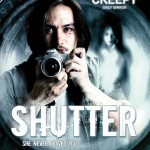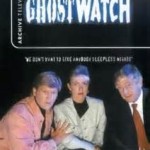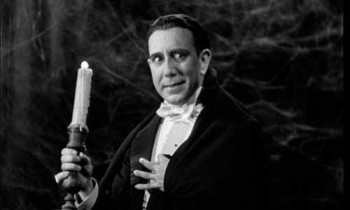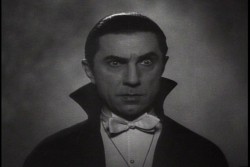Frankenstein!
Say it and an image immediately pops into people’s heads. The flat head, the electrodes in the neck (that everyone mistakenly calls bolts), the green skin, the heavily lidded eyes, and the lumbering movement.
And not one bit of that description appears anywhere in Mary Shelly’s original novel.
No, you can thank the 1931 motion picture for the popular image of the Frankenstein monster, and for cementing him as an icon of our culture.
To be fair the movie is also largely based on a stage play version, written by Peggy Webling.
One of the challenges in attempting to review this film is to separate it from the very pop culture it spawned.
The movie has an interesting opening. A well-dressed man steps out from behind a curtain. Speaking directly to the audience he warns them that what they are about to see may shock and horrify them.
Then we go to credits. I’ll be honest; I’m not sure what is up with the credits. Behind the title of the movie is the top half of someone’s head and beams are shooting from the eyes. The next part where the cast and crew credits are shown have a swirling kaleidoscope of eyes.
There are two interesting notes in the credits. First is that the monster gets fourth billing and is billed as being played by “?”. These credits are given again at the end and “?” is replace by Boris Karloff.
The other odd credit is “Based on the Novel by Mrs. Percy B. Shelly”. I have not found any reason that Mary Shelly was referred to this way. I have to assume it was just the casual sexism of the 1930s.
I’m not going to do a scene-by-scene break down, so here is the summary:
The first part of the film details Dr. Henry Frankenstein’s efforts to create life by building a body from recent corpses and animating it by way of a new wave length of energy he has discovered. Once he succeeds, the film details the struggle of the Doctor with this new life he has created, and his creation’s attempt to understand the world he has been born too. This spirals out of control as the creature becomes violent due to abuse at the hands of Frankenstein’s assistant Fritz. Tragedy ensues leading to the monster’s demise and the Doctor nearly dying himself.
So let’s start with what works. And the first thing I want to point out is the performance of Colin Clive as Henry Frankenstein. I think this role gets glossed over often, due to everyone focusing on Karloff’s performance as the monster. But the movie is as much about Henry as it is the creature. He is a man obsessed, but the foundation of what he is doing is sound. Clive has a great speech shortly after the creature is brought to life about scientific exploration and how its boundaries need to be pushed if anything is to be achieved. However, he has moments that show he is not as well hinged as he wants others to believe. He has bouts of mania and despair. A more modern film would probably come right out and say was suffering from bipolar disorder. While a little over the top for modern tastes, for the era it was a really good performance. His lines “It’s alive, it’s alive, it’s alive” and “Now I know what it feels like to be God” are classics, and often quoted. This performance set the precedent for all film mad scientists that would come after.
Another stand out is Dwight Frye as Fritz, Frankenstein’s hunchbacked assistant. If Clive set the mold of the Mad Scientist then Frye set the mold for deranged lab assistant. While the level of Henry’s obsession is a slow burn at first, that something is not right with Fritz is clear from the beginning and has nothing to do with his physical deformity. Frye portrays Fritz’s madness well, and walks a fine line in playing big yet never going over the top. Every Igor that followed owes Fritz a debt.
And of course you have Karloff as the monster. There is a reason that this role became an icon. Aided by the amazing make up work of Jack Pierce, Karloff portrayed the creature to perfection. The creature is both innocent and menacing. Karloff wanted to make sure that there was more going on than just a lumbering beast and he succeeded. There is a reason the creature is often portrayed as the good guy in many of the stories and adaptations that followed, and it all goes back to Karloff.
You also have a fine performance from Edward Van Sloan as Henry’s mentor Dr. Walden (he also played the well-dressed man at the opening warning to the audience), who is horrified at what Henry has done, and yet can’t resist the fascination of the science, and a decent performance from Marilyn Harris as the little girl who befriends the monster only to be killed because the creature doesn’t know how strong it really is.
A lot of credit for the success of the movie has to go to director James Whale. His pacing keeps the audience’s attention even 80 years later.
But not everything holds up.
Mae Clarke as Frankenstein’s fiancée Elizabeth is a throw-away part. Her whole purpose in the movie seems to be to worry about Henry and in turn to have him worry about her. While the subplot of their wedding helps drive some of the action, she is not a compelling character.
But even worse is Frederick Kerr as Henry’s father Baron Frankenstein. He is basically a blustering old fool. He adds little to the plot, and at best seems to be comic relief.
The Baron also brings up another point that does work now. Just where the hell is the movie set? In the original novel it was Switzerland, and the movie has hints of this, but it might also be Germany. That would be great but the various characters have a wide range of accents. I’m sure it comes down no one carrying about the accents that much. But if you think about it for a minute it is just weird.
The sets are another issue. Specifically several outdoor scenes are clearly filmed in-studio and you can see streaks on the back drop.
There was also the tacked-on happy ending. It is pretty clear that originally Frankenstein was going to die at the hands of his creation. The studio was not happy with that and had a final scene added that showed Henry convalescing with his father doddering about. In fairness, this scene left the door open for the sequel which many feel is a superior film.
The legacy of this film more than makes up for the short comings I have presented. As I said before, the image of the monster from this movie has become iconic. Every Frankenstein’s monster that has come after is compared to Karloff’s. Also many of the trappings we associate with the story were started here. Nowhere in the Shelly novel is the means of the monster’s creation detailed. But the use of electricity has become common due to the films influence. The same is true of the lab assistant. In the novel, Frankenstein worked alone.
I would also argue that the misunderstood monster came from here. Early scenes with the creature show that it was not inherently aggressive, and that it even wanted a connection with its creator. It was abuse from Fritz and the revulsion of Dr. Walden that made it lash out. Even the death of the little girl was not intentional and clearly upset the creature greatly when he realized she was dead.
And again, Dwight Frye’s Fritz set the tone for the horror film henchman. You see this from Ygor in Son of Frankenstein to Willy Lomas in Dark Shadows and even Riff Raff in the Rocky Horror Picture Show.
The same is true of Colin Clive’s Dr. Frankenstein. It’s not even worth listing them all. Look at a crazed or obsessed scientist in any move since and you will see echoes of Clive’s performance.
Another influence is in the torch-wielding mob. This has become as much a staple as the gothic castle. And speaking of gothic castles, while this movie did not originate that, it was the first use of the castle thunder effect, and that trope it did start.
I think it also needs credit for kicking off the career of Boris Karloff. His contribution to film and television is significant, and had James Whale not seen him in the Universal commissary, we would have never had him as the narrator of How the Grinch Stole Christmas.
Finally, this movie is what truly kicked off Universal Horror. Even though Dracula came first, it was Frankenstein’s success that proved to the studio that there was an ongoing audience for horror.
Speaking of Dracula, next time we delve into the Universal Horror vault, we will take a look at the 1931 film with Bela Lugosi.
 Shutter is a horror film made in Thailand, in 2004. It is clearly inspired by the wave of horror films, coming predominately from Japan, that have come to be known as J-Horror.
Shutter is a horror film made in Thailand, in 2004. It is clearly inspired by the wave of horror films, coming predominately from Japan, that have come to be known as J-Horror.



.jpg)